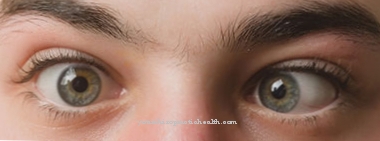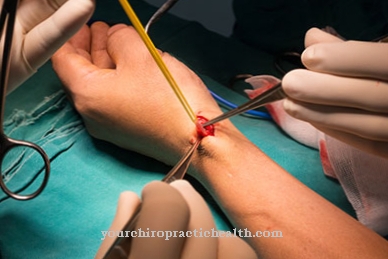A Pyoderma is not a primary disease. It can be caused by a disturbance of the immune system, by other primary diseases, by skin infections, but also by streptococci or staphylococci.
What is pyoderma?

© GraphicsRF - stock.adobe.com
At a Pyoderma it is a burning and purulent skin inflammation that can affect different layers of the skin. In most cases, the triggers are β-hemolytic streptococci and staphylococci known as pus bacteria. There are three types:
- Surface pyodermia
Only the uppermost layers of the epidermis are affected. There are four special forms: intertrigo (a skin fold dermatitis), pyotraumatic dermatitis (hot spot), bacterial overgrowth syndrome and mucocutaneous pyoderma.
- The superficial pyoderma
Deeper layers of the epidermis are also affected, particularly in the area of the hair follicles. The infection, however, remains above the basal lamina. Three special forms are known here: impetigo (highly contagious), bullous impetigo and folliculitis (superficial and bacterial).
- The deep pyoderma
Infection also occurs in the dermis or even the subcutis. Possible are: folliculitis (most common form), furunculosis (hair follicle is infected and can be destroyed), cellulitis (the subcutaneous tissue is also infected)
causes
Bacteria, which are also found on healthy skin, together with malassezia (yeast fungi) form the normal flora of the skin. If the body's own defense system is healthy and therefore functional, the bacteria and yeast cannot multiply pathologically. Penetration into the deeper layers of the skin and an infection do not occur.
However, if the skin is injured or damaged by an illness, the bacteria that cause infection have an easy time of it. There is a pus formation, the pyoderma. Pyoderma is therefore not only triggered by infection, but also by a malfunctioning immune system. Another trigger for pyoderma are various diseases.
A hormonal disease such as thyroid disease or an overactive kidney (cuching) can be responsible. In any case, the triggering factor must be found, since pyoderma is not a primary disease. Another cause can be allergic skin reactions.
For example, a flea bite allergy, a food allergy or atopy. If there is a pre-existing skin disease, for example neurodermatitis, the risk of infection is many times greater and the course of pyoderma is often more severe.
Symptoms, ailments & signs
The symptoms of pyoderma are very complex. Itching, flaking and redness as well as crusting are typical symptoms, as is skin discoloration. The abdomen, the inside of the thighs and the flanks are particularly often affected. The head and legs (not the spaces between the toes) are less likely to be affected.
In children, especially toddlers and kindergarten children, there is usually impetigo contagiosa, which is an inflammation of the epidermis. The transmission by staphylococci or streptococci leads to skin vesicles of different sizes with a reddened edge and a purulent opacity.
The small blisters burst very easily and quickly. As a result, honey-yellow crusts appear and the foci of infection spread. It is transmitted to other skin regions or to other people through the fingers that have come into contact with the infected areas.
Diagnosis & course of disease
A clinical examination, including a laboratory analysis, is usually carried out with or without a skin swab. If there is a deeper inflammation, a bacterial culture is created. This can be done with or without a skin biopsy. If the bacteria causing the infection penetrate the deeper layers of the skin, this can impair the general condition and lead to nausea.
Not only the skin, but the entire organism is then affected. Transmission from other people can also be considered for diagnosis. It is not uncommon for toddlers and kindergarten children to be staphylococci or streptococci that have been transmitted from the throat of another child by droplet infection. Complications are less common.
However, an infection by streptococci can trigger the secondary streptococcal diseases that also occur with scarlet fever. When infected by staphylococci, there is a risk of Lyell's syndrome (reaction of the immune system to a staphylococcal infection in a different area of the skin).
Complications
As a rule, pyoderma is already a complication of another underlying disease. Those affected suffer from various complaints, which, however, always occur on the skin. This usually leads to severe itching and severe reddening of the skin. The skin itself is very dry and irritated.
In many cases, the patients feel ashamed of the symptoms of pyoderma and therefore also suffer from inferiority complexes and a reduced self-esteem. The illness can also cause depression or other psychological disorders. Furthermore, it can also lead to the formation of blisters on the skin. The vesicles themselves are painful and can easily burst. Pyoderma can also spread to other regions of the skin.
Due to the relatively high risk of infection, contact with other people should also be avoided. Furthermore, pyoderma often leads to nausea or a general feeling of illness in the person affected. Treatment of pyoderma is carried out without complications with the help of antibiotics. The life expectancy of the patient is not affected by the pyoderma.
When should you go to the doctor?
Pyoderma should always be treated by a doctor. Only with proper treatment can further complications and complaints be prevented. An early diagnosis and treatment of pyoderma always have a positive effect on the further course. A doctor should be consulted if the person concerned suffers from various skin complaints that do not go away on their own and usually occur without a particular reason. This mainly leads to severe itching and reddening of the affected areas.
The entire body can be affected by the symptoms of pyoderma. Also, blisters on the skin can indicate pyoderma and should be examined by a doctor. Since the disease can also be transmitted to other people through skin contact, skin contact should be avoided for the time being. Pyoderma can be treated by a general practitioner or a dermatologist. As a rule, there are no particular complications, and the life expectancy of the person affected is not reduced.
Treatment & Therapy
As already mentioned, pyoderma is not a primary disease, so it is essential to clarify the underlying disease. If this can be successfully treated, a recurrence of the skin infection can usually be prevented. Pyoderma in and of itself is treated with antibiotics.
It is important to take antibiotics for at least a week after healing. When this stage is reached is again determined by laboratory technology. In most cases, the duration of treatment is three to four weeks. A check-up should be carried out after the first half of the treatment period.
This enables an individual determination of the intake of an antibiotic. Sprays and rinses are also used. They can not only reduce the odor, but also speed up healing. Particularly susceptible areas can also be specifically treated.
The therapeutically used shampoos are highly antibacterial and must be massaged in for at least ten minutes. This is the only way to ensure that the contact time with the skin is sufficient to kill the bacteria. Thorough rinsing is also very important.
You can find your medication here
➔ Medicines against redness and eczemaprevention
It is important to have age-appropriate skin care that does not attack the skin's natural protective acid mantle and protects and, if necessary, restores and maintains the skin's natural moisture content. Ph-neutral urea-containing ointments or lotions are considered to be very beneficial. The gel of the aloe vera plant also supports the natural protective mechanism and thus also helps keep the skin healthy.
Surfactants should not be used as they damage the skin in its natural healthy function. In addition, the body's own fat is extracted. The skin dries out. If you have naturally dry skin, you should only shower briefly and not so hot.
Aftercare
After successful treatment of pyoderma, the primary concern is to avoid recurrence of pyoderma. Regular and intensive personal hygiene is very important for this. It is also advisable to prevent the occurrence of serious, sometimes fatal, secondary diseases (especially sepsis and acne inverses). Intensive personal hygiene is also necessary for this.
In addition to washing with soap and disinfecting your hands, especially after visiting public toilets, you should shower daily. In addition, intensive skin care is beneficial to prevent pyoderma from recurring. This should consist of rinsing the skin regularly with pH-neutral cleaning agents and eating a diet rich in vitamin A that is healthy for the skin.
In addition, the inflammation values in the blood should be checked regularly by the responsible general practitioner or specialist in order to detect the recurrence of pyoderma and the occurrence of secondary diseases at an early stage.In addition, long-term therapy with antibiotics may also be indicated after successful treatment of pyoderma.
This is particularly the case if secondary diseases have already occurred. Here, too, the blood values should be checked regularly. In the case of Acne Inversa, additional skin surgeries may be necessary to remove the inflamed tissue.

.jpg)










.jpg)



.jpg)










.jpg)
